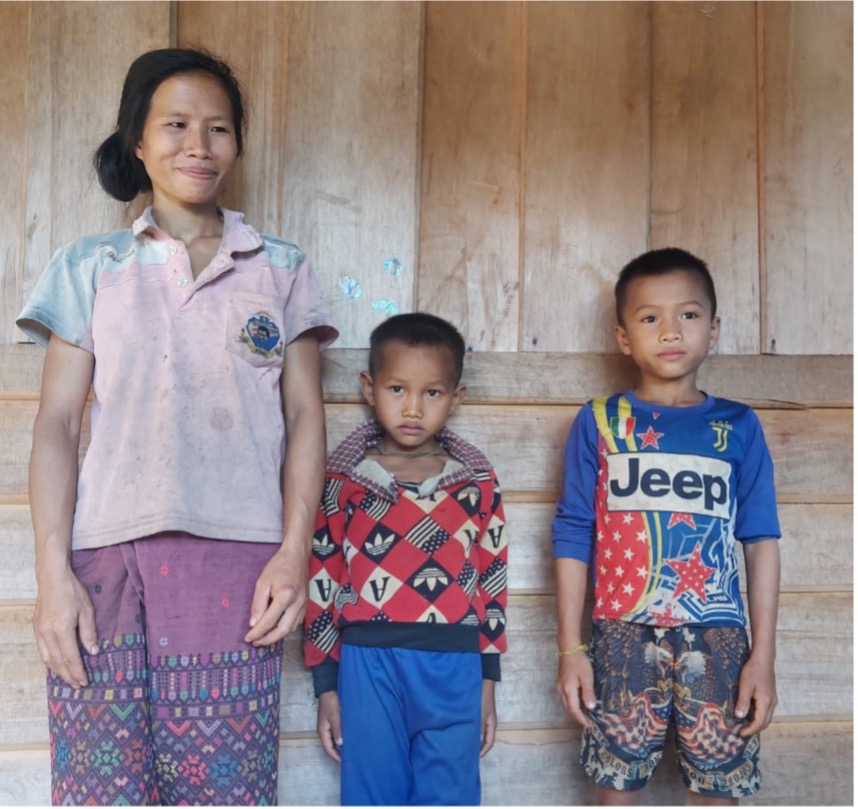“Many species are thriving as indicated by the sound of the birds and by the song of gibbons I can hear in the morning even from my house.”
Mrs. Maipom Saysomphone, 28 years old, was born in Meungcham village, Xaychamphone District of Bolikhamxay. She is married to Mr. Bounsing and they have two sons, 9 and 7 years old. The family of four lives in her husband’s village, Sopkhone. She first became involved in The Ecosystem Conservation through Integrated Landscape Management in Lao PDR (ECILL) project when her village became a Guardian village of Phou Sithone Endangered Species Conservation Area.

GUARDIAN VILLAGES
Guardian Villages have a direct impact on Protected Areas and are in turn impacted by the Protected Area management decisions. Guardian Villages’ are the gatekeepers of the Protected Area, and as such, their activities can either contribute to the integrity of the Protected Area or present a threat to the biodiversity of the Protected Area. It is thus in the interests of the Protected Area management to develop a relationship of mutual cooperation and respect with Guardian Village’s, ultimately aiming for a strong co-management and developmental support relationship.
“We will help to protect the forest, we won’t go hunting or damage resources, because the conservation of Phou Sithone brings us incentives and support our livelihoods.”
The family owns 0.5 hectares of paddies and they cultivated the upland fields to complement their annual rice consumption needs (about 1.5 tons in total). They raise animals: 1 buffalo, 2 pigs and 10 chickens. Additional income was provided from the selling of wild nuts (Mak Ko) collected in forest, which generates about US$100 per year. The family house was made of bamboo with a roof constructed from palms, which is an indicator of poverty.
VILLAGE INCENTIVE FUNDED ACTIVITIES
With support from the ECILL project, the family received a revolving fund to develop handicrafts through the women’s groups. The family received about 875,000kip (US$80 in 2020) to develop a small handicraft business, which is to be reimbursed after 3 years without interest. Mrs. Maipom invested in small equipment and materials to make sticky rice containers (“tip khao”) with the support from the program staff. The products are sold at the District center and to middlemen for resale. To date, the production and value chain has successfully developed and the annual income generated is about 25 Million kip per year, almost US$2,000$ per year. For the family this is an extremely significant increase to the family’s livelihood and annual revenue.
IMPACT OF INCREASED LIVELIHOOD

With the increase of annual income, almost $2,000 per year, they have been able to purchase materials and improved their home. Their walls are now sturdy plank wood and the palm roof has been replaced with metal sheets. They have also increased their area of paddy field area by 0.2 hectors. Increasing their paddy field has allowed them to reduce the time spent in the uplands and stopped the use of slash and burn methods.
“Thanks to the selling of handicraft, we can send our children to school, have money to go to hospital and for healthcare, make the family's life better.”
The impact on women is that “by stopping slash and burn for upland farming, I have enough time for working at home, unlike in the past when I had to overnight on the upland farm, and clearing weeds is a very difficult life. There was no time to socialize and to be creative with friends. Now there is more time at home with family.”
Mrs. Maipom proposed to the project to provide more equipment and organize a study tour, which are now being discussed to further support livelihoods.
IMPACT ON CONSERVATION
The Village Incentive Fund provides support to livelihoods that ultimately impacts conservation positively. Thanks to the benefits and improvement of livelihoods. If the program had not protected the Phou Sithone ESCA, villagers would have deteriorated the forests and continued to hunt wildlife. Some species would have gone extinct already.
The ECILL program is a partnership between Agence Française de Développement (AFD), the European Union (EU) and the Wildlife Conservation Society (WCS) in joint efforts with the Lao government and local communities to protect the Lao PDR’s unique biodiversity and sustainable use of natural resources. This work is carried out in key landscapes in Lao PDR such as the Xe Champhone Ramsar Wetland Complex in Savannakhet Province, Nam Kading National Protected Area and Phou Sithone Endangered Species Conservation Area in Bolikhamxay Province, and Nam Et-Phou Louey National Park.